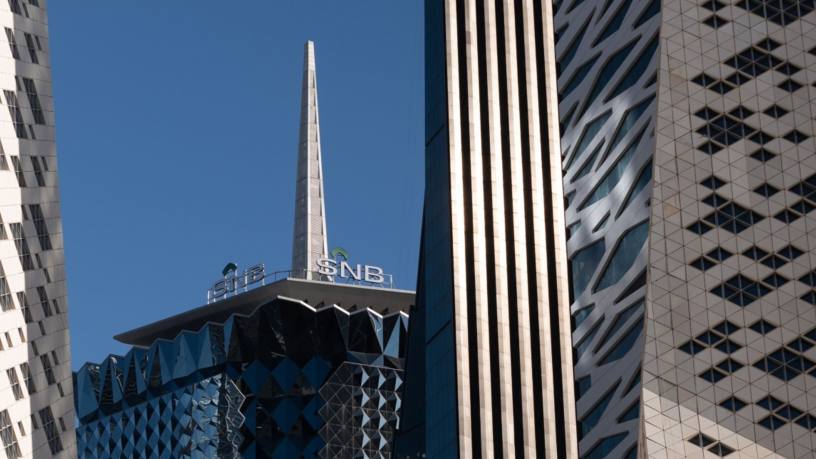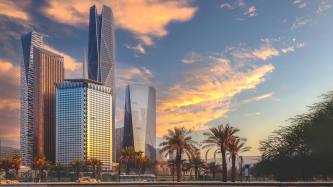At the aggregate level, The Banker’s Top 100 Arab Banks ranking for 2023 paints a picture of a region that has successfully navigated the headwinds experienced by their global peers. As a bloc, lenders in the Arab world registered increases in Tier 1 capital, assets and profits for 2022 — in contrast to the declines posted by the rest of the world’s Top 1000 banks.
As in previous years, however, the headline figure obscures important variations in performance across the region, with the contrast in fortunes as stark as ever in the 2023 ranking. Although lenders in oil-exporting states such as Saudi Arabia and the UAE continue to thrive, banks in the wider region saw decreases in dollar terms more in line with their global peers, thanks to difficult economic conditions and depreciating local currencies.
While banks in the six countries of the Gulf Co-operation Council (GCC) registered a 7.7% cumulative rise in Tier 1 capital for 2022, lenders in the rest of the region recorded a 5% drop for the same period, with similar disparities in asset and profit growth.
The regional bifurcation is exemplified by the contrasting fortunes of Saudi Arabia and Egypt, hitherto the Arab world’s two most prolific growth markets. Saudi lenders continued to thrive in 2022; an oil-revenue windfall stemming from Russia’s invasion of Ukraine underpinned strength in corporate lending, with the riyal’s peg to the dollar keeping inflation low.
By contrast, the Russia–Ukraine war had a disastrous impact on Egypt, the Arab world’s most populous nation. A collapse in foreign exchange reserves torpedoed the country’s rapidly expanding, but fragile, economy. Soaring inflation and a series of currency devaluations have left local lenders reeling, with headline metrics experiencing severe declines in dollar terms for the year.
Saudi lenders make up 25% of assets and around a third of Tier 1 capital in this year’s ranking, with four banks in the top 10. While the country’s retail mortgage boom — which has underpinned unprecedented asset growth in the past five years — is showing signs of slowing, lenders benefited from an increase in public spending thanks to a surge in oil revenues, with megaprojects such as Neom and the Red Sea Project fuelling strong demand for corporate credit.
The longevity of such demand is uncertain however; having recorded the strongest growth in the G20 in 2022, Saudi Arabia’s economic growth is set to fall from 8.7% to just 1.9% in 2023, according to the International Monetary Fund (IMF), attributable to oil production cuts announced by the country in April and June.
Saudi National Bank (SNB) retains its position as the largest Arab lender by Tier 1 capital for 2023 — a position it first gained in last year’s ranking — even as a drop in deposits dampened asset and Tier 1 capital growth during 2022. Yet the bank — created through the merger of National Commercial Bank and Samba Financial Group in 2021 — saw pre-tax profits rise by an impressive 47.4%, higher than any other Saudi lender and any Arab lender with assets of more than $70bn, as post-merger efficiency gains saw costs fall.
Despite SNB’s strong showing in performance metrics such as profitability, operational efficiency and return on risk, it is the country’s second-largest bank, Al Rajhi, that has gained the crown as Saudi Arabia’s best-performing bank for 2023. It rises from third place last year to force Saudi Awwal Bank (formerly Saudi Arabia British Bank) from the top of the table. SNB remains in third position in terms of overall performance, weighed down by lower scores for growth, soundness and liquidity.
Al Rajhi’s ascent to the top of the performance tables comes after a watershed year for the world’s largest Islamic lender. The bank reported an impressive 43.8% boost in its Tier 1 capital in 2022 — the highest non-acquisition-related increase of any Arab lender, and of any lender in the world with assets in excess of $100bn.
This growth was fuelled by a 57% rise in corporate lending and a 30% rise in mortgages. Al Rajhi, which ranked third in 2022’s performance table, also posted table-topping scores for metrics including asset quality and leverage, ranking highest in Saudi Arabia in terms of return on assets and return on capital (ROC). Al Rajhi Bank remains the best performer of the top-six Arab banks by ROC, even though its figure dropped from 21.01% in 2021 to 16.99% in 2022. SNB saw the best improvement in terms of the big six — its ROC increasing from 10.45% to 14.71%.
Riyad Bank, the third-largest lender in the country ranking, comes in second in terms of overall performance in Saudi Arabia, compared with its fourth-place finish in 2022. The bank recorded an 18.5% rise in Tier 1 capital for the year — second only to Al Rajhi in the country — which sees it move up one place to sixth in the overall Arab ranking.
The lender’s performance score was boosted by a table-topping performance for soundness, thanks to a healthy rise in its capital to assets ratio during 2022, together with a strong score for leverage.
Between 2017 and 2021, Egypt’s lenders had been among the fastest-growing banks across the developing world. State-owned lenders National Bank of Egypt and Banque Misr had been the main engine of growth, registering double-digit growth in assets and Tier 1 capital on an annual basis, ranking among the top 20 Arab banks in last year’s ranking.
the Egyptian government once again obliged to devalue the local currency and seek support from the IMF
After a slowdown in 2021, however, the trend has gone into reverse with the Egyptian government once again obliged to devalue the local currency and seek support from the IMF. The collapse in value of the Egyptian pound has hit banks’ headline numbers hard, with six of the 10 lenders in this year’s ranking registering Tier 1 capital declines of more than 20% for 2022.
Excluding Afreximbank — the Cairo-based development lender that saw its capital base surge in 2022 thanks to a capital raising programme — Egyptian lenders in this year’s ranking saw their Tier 1 capital position plummet by 24.3% for the year in dollar terms. While CIB Egypt, the country’s largest private lender, recorded a slight increase in Tier 1 capital in local currency terms in 2022, when converted to dollars it decreased by 36.2% — one of the biggest falls in 2023’s overall ranking.
National Bank of Egypt and Banque Misr had yet to publish or provide end-of-year data for 2022 at time of writing, and are therefore not included in this year’s ranking, having changed their reporting cycle from the end of June to the end of December.
Lenders in Morocco, the second-largest non-GCC banking market behind Egypt, also suffered from the depreciation of the dirham against the dollar in 2022, even as the impact was more muted than for Egyptian lenders. All nine of the country’s lenders in this year’s ranking recorded a drop in assets in dollar terms in 2022, with Crédit Immobilier et Hôtelier (CIH) the only one to witness an improvement in Tier 1 capital.
Attijariwafa, the country’s largest lender, recorded positive results for the year, but saw its Tier 1 capital position weaken by 5.8% in dollar terms. The lender, which slips three places to 25th in the overall ranking, also comes out on top in Morocco for its overall performance, thanks to table-topping scores for profitability, asset quality, operational efficiency and return on risk. Groupe Banques Populaire, the country’s second-largest lender, also ranks second in performance terms, thanks to high scores for liquidity, soundness and leverage.
The UAE remains the Arab world’s second-largest banking market after Saudi Arabia, with more lenders (18) in this year’s Top 100 than any other country. After a muted performance in last year’s ranking, the country’s lenders registered a 5% increase in Tier 1 capital in this year’s ranking, with seven lenders recording a double-digit growth in assets.
Emirates NBD led the way in terms of Tier 1 capital growth, with an 11.9% rise for 2022. The rise saw the Dubai-based bank overtake First Abu Dhabi Bank (FAB) to become the country’s largest lender in the overall ranking, remaining in fourth place overall. While FAB slipped from third to fifth position in the overall ranking on the back of an unchanged Tier 1 capital position for the year, it remains the country’s largest lender by assets by a comfortable margin. FAB’s asset base grew by 11% during 2022, thanks to a 14% rise in deposits for the year.
Emirati banks registered significant improvements in profitability in 2022 amid increasingly favourable business conditions in the UAE. While Habib Bank Zurich, Emirates NBD and Abu Dhabi Islamic Bank all posted increases of more than 50% in pre-tax profits for the year, top spot for the country and the region belongs to Mashreqbank. The Dubai-based lender — the country’s fifth largest — recorded a 250% rise in pre-tax profits in 2022, thanks to a 29% rise in operating income and a 76% drop in impairment allowances for the year.
Strong profits helped Mashreq retain its position as the UAE’s best-performing bank for the second year in a row, recording table-topping scores for growth, profitability, asset quality, return on risk and liquidity. Emirates NBD rises from fifth to second place, thanks to high scores for operational efficiency, soundness, growth and profitability.
While merger and acquisition activity has cooled somewhat in recent years, the past year saw the completion of the long-gestating deal between Kuwait Finance House (KFH) and Bahrain’s Ahli United Bank. Under consideration since 2018, KFH completed the takeover in October — after it was placed under review at the beginning of the Covid-19 pandemic — marking a rare Middle Eastern cross-border merger.
The acquisition helped KFH register a 51.7% rise in Tier 1 capital and a 64% growth in assets, the highest increases of any Arab lender with an asset base of more than $1bn, and sees the bank rise five places to 10th in the overall ranking. While it remains just below ninth-placed National Bank of Kuwait (NBK) in terms of Tier 1 capital, KFH has overtaken its domestic rival to become the country’s largest bank by assets.
KFH has also risen from third to first place in the country’s performance table, with top scores for growth, asset quality, liquidity and leverage. NBK rises from fourth to second place, with high scores for return on risk, liquidity, profitability and growth.
Capital Bank of Jordan (CBJ) announced plans in February 2022 to acquire local rival Société Générale (SocGen) Bank Jordan for a consideration of $205m. The deal, completed in October, came a year after CBJ acquired the Jordanian and Iraqi assets of troubled Lebanese lender Banque Audi. CBJ received a further boost in June 2022 with the acquisition of a 24% stake in the lender by Saudi Arabia’s Public Investment Fund.
The SocGen acquisition helped CBJ achieve a 63.6% rise in Tier 1 capital — the second-largest in this year’s ranking — raising it from fifth to third position in the Jordanian market and from 91st to 67th in the overall ranking. The bank also tops Jordan’s performance ranking for 2023, with strong scores for growth, liquidity and operational efficiency. Bank of Jordan, the country’s fourth-largest lender, comes in second place, thanks to high scores for soundness, leverage, return on risk and profitability.
Despite having been overtaken by SNB as the region’s largest bank by Tier 1 capital in 2022’s ranking, Qatar National Bank (QNB) remains the Arab world’s largest bank by assets by some distance, with nearly $25bn in assets separating it from second-placed FAB. This year’s ranking saw Qatar’s smaller lenders outperform their regional counterparts, with QNB being the only Qatari lender not to improve its position in the Top 100.
Qatar Islamic Bank (QIB) was the pick of the country’s larger lenders, its 9.1% rise in Tier 1 capital seeing it rise two places to 15th in the overall ranking. Qatar First Bank — which announced a name change to Lesha Bank in October 2022 — saw its Tier 1 capital base double to $316m for the year, helping it enter the Top 100 Arab Banks in 99th position.
QIB, the country’s second-largest lender, tops the performance ranking for Qatar for the second year in a row, thanks to table-topping metrics for profitability, asset quality, return on risk, soundness and leverage. Commercial Bank, the country’s fourth-largest lender, rises from third to second place in the performance chart, thanks to strong scores for operational efficiency, growth and profitability.













